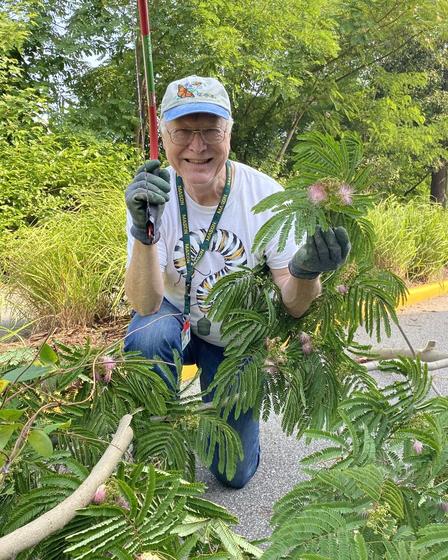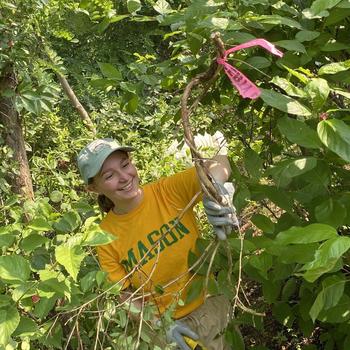In This Story
When you hear the word “mimosa,” what first comes to mind? If you think about a bubbly beverage enjoyed at brunch, you’re not wrong—but if you think of a flowering tree that is considered invasive to the Northern Virginia ecosystem? You’re also not wrong.

George Mason University’s Potomac Environmental Research and Education Center (PEREC) recently hosted an invasive species removal event where students, faculty, staff, and community members came together to remove harmful, invasive plants around the Potomac Science Center in Woodbridge, Virginia.
The mimosa trees were one of the main species removed. The delicate, sweet-smelling blossoms make the mimosa an attractive ornamental tree—the main reason these plants were transported to North America. Originally native to central China, Japan, and South Korea, the mimosa is a vigorous grower and produces a high number of seeds, making it an ecological threat to native species.
“Invasive plants are non-native or introduced to an ecosystem and can cause environmental or economic harm,” said Cindy Smith, PhD Environmental Science and Public Policy ’05, associate professor in the Department of Environmental Science and Policy and K-12 education and outreach director for PEREC. “They can grow faster than native species, often shading out natives, spread quickly, and may not be a great food source for native birds and insects.”
The term “invasive” does not only apply to plants, trees, and shrubs. “We also have invasive insects, worms, pigs, mollusks, crustaceans, and fish in Virginia,” said Smith.

A variety of conditions allow invasive species to thrive.
“When the Potomac Science Center first opened in 2018, we noticed a couple of beavers munching the trees around the retention pond perimeter,” said Smith. “The beavers mowed down many of the native oak, sycamore, and maple trees, creating a sunny opening for fast-growing invasives to take off and thrive.”

Callery pear trees and Japanese honeysuckle, along with the mimosas, were crowding and taking over the pond perimeter. Japanese honeysuckle vine overtakes shrubs and can choke trees. Callery pear trees spread profusely in areas that do not benefit from their presence—along shorelines, in open fields, farmland, and roadside ditches.
Removing invasive species allows native plants to thrive, including those that are part of the Mason Arboretum. Native vegetation also supports native birds and insects. PEREC is cataloging the native plants around the Potomac Science Center so that visitors who walk along the trail can learn about what is growing at the site.
